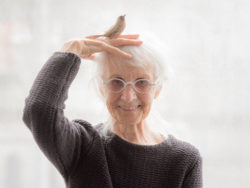International Women’s Day: IO Van Oostveldt, Between Clothing and Art

'Geometrically Wired' offers a glimpse into the multifaceted creativity of IO Van Oostveldt, Belgian artist and ‘the wife of’. The exhibition simultaneously shows how traditional gender roles led her to end up in the shadows as an artist, and on the sidelines in fashion.

IO Van Oostveldt (°1928) was married to Belgian artist Mark Verstockt. They met at the Royal Academy of Fine Arts in Antwerp. From their first meeting, they were bound by a shared fascination for geometry: "I was alone in the classroom when a young guy came in and asked if it was where our class was meeting", she recalls. "I was holding a frame - a square that I was trying to stretch a canvas across. Our first conversation took place because of that empty square. That square has determined our whole lives." After their marriage in 1953, her career took a different turn, as traditional gender roles were still in force, even in artistic circles: "We were at art school together, but when the children arrived, he said, 'There can't be two artists in a single household...' And who was that artist?", she laughs. IO cared for the family and started making her own clothes for financial reasons.
Creative with clothes
As a couple, they soon became part of the international art scene. His exhibitions travelled the world. IO helped Mark prepare canvasses and execute monumental works. But it is also IO who ran the household, finding creative solutions for the tight family budget: "Two artists, three children: there had to be some money coming in. Besides, I was not satisfied with the fashion you saw in the shops back then. So I started fiddling a bit myself." IO's experiments fit the zeitgeist. After all, by the mid-1960s, fashion was becoming more youthful and creative. The geometric language of form - also present in Mark Verstockt's art - was translated to fashion by Pierre Cardin and André Courrèges. "I was an outsider, not a real fashion designer - I had no pretensions about that. I always wanted to try out things,” IO stresses. "I only knew the basics of sewing. But women didn't go to work in those days and I immediately found a dozen or so in my network who were enthusiastic and wanted to come and sew and knit with me. That's how it all started..."
Knitting success
In the late 1960s, she began experimenting with the knitting machine. Her creations are reminiscent of the knitwear of Ann Salens, a contemporary of IO, but IO’s work is distinctive in its monochrome use of colour and geometric lines: "I didn't want to make difficult things, and worked with squares and circles, sometimes triangles. Everything had to be easy as well, for example, in a poncho you could pull over whatever you were wearing when you went out in the evening." She also makes brightly coloured satin or velvet handbags with bird, flower and lace appliqués. Her designs stand out when she attends openings with Mark, and orders come in fast. Her customers are mostly upper-middle-class women willing to pay for one-of-a-kind pieces.
Lurex chenille
Lurex, sequins, glitter and gloss: the seventies are synonymous with disco fever. Sitting by the Christmas tree, IO gets the idea for a lurex chenille: "I saw a garland twinkling in the tree and thought: ‘Why not knit with this?’ I gave it a try it and it looked good. Next, I went to a manufacturer and asked if they could produce the thread in such a way that it also felt pleasant to wear. They immediately said yes and were very enthusiastic." IO funded the project and, after considerable experimentation, they came up with a chenille yarn with a glitter effect, of which the twisted base thread contained small pieces of lurex. However, this was soon followed by disappointment: when she was ready to market the collection, it turned out that the manufacturer had already put the yarn on the market without consulting her.
Brickwork blouse
As a result, a disillusioned IO shelved her fashion ambitions and towards the end of the 1980s she refocused on her visual art: "I made a few more things, including a wedding dress with scores of squares. We developed this geometric language, it was only natural to continue along those lines..." The design for a brick-patterned kimono-shaped top was executed as a blouse in silkscreened voile in the 1990s. Her fascination with geometric lines and recuperated materials resonate strongly in her design drawings, even more so than in her fashion creations. Despite the traditional role division, there was always a mutual influence between the work of IO Van Oostveldt and Mark Verstockt.

'Geometrically Wired. IO Van Oostveldt: Between Clothing and Art' can be seen from 25 February through 30 July 2023. More info and tickets available here











